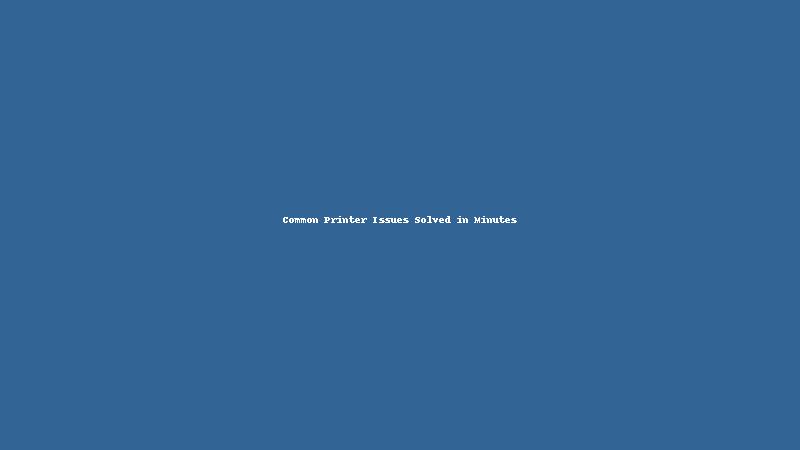
Printers are essential for both home and office environments, but they often come with a variety of issues. Whether it’s a paper jam, poor print quality, or connectivity problems, dealing with printer malfunctions can be frustrating. Luckily, many printer issues can be resolved in just a few minutes without the need for a technician. In this article, we will explore the most common printer problems and provide simple solutions to get your printer working again. Keep reading for easy troubleshooting tips for quick printer repairing.
1. Paper Jams: How to Fix Them Quickly
One of the most common issues with printers is a paper jam. This can happen for various reasons, such as incorrect paper loading, worn-out rollers, or debris in the paper path. Fortunately, resolving paper jams is straightforward if you follow a few simple steps.
Remove the Jammed Paper Carefully
The first step in printer repairing when dealing with a paper jam is to carefully remove the jammed paper. Turn off the printer and gently pull the paper out. Be sure to remove any torn bits of paper that may be stuck in the rollers or the paper tray. If the paper is stuck in the back of the printer, use the rear access panel (if available) to pull the paper out. Avoid pulling too hard, as this can damage the internal components.
Clean the Rollers
Sometimes, paper jams occur because the rollers that feed the paper are dirty or worn out. Cleaning the rollers is an essential part of regular printer maintenance. You can use a soft cloth and a small amount of water to clean the rollers, making sure they are free from dust and debris. If the rollers appear worn out or damaged, it may be time to replace them.
Check the Paper Tray
Another reason for paper jams is improper paper loading. Ensure that the paper in the tray is properly aligned and not overloaded. Make sure the paper size is set correctly in the printer’s settings, and avoid mixing different types of paper in the same tray.
2. Poor Print Quality: Getting Clear Prints Again
If your printer is producing faded prints or streaks, it’s likely due to issues with ink or toner. This problem can often be fixed within minutes with a few simple steps.
Check the Ink or Toner Cartridges
One of the first things you should check when troubleshooting poor print quality is the ink or toner cartridges. If the ink levels are low, replace the cartridges with new ones. For laser printers, ensure the toner cartridge is installed correctly and not clogged. In some cases, a simple printer repair, like replacing a low toner cartridge, can drastically improve print quality.
Clean the Print Heads
Clogged print heads are another common cause of poor print quality. Most modern printers have a built-in function for cleaning print heads. You can usually find this option in your printer’s settings menu. Running a print head cleaning cycle can help eliminate streaks and smudges from your printouts. If the issue persists, you may need to manually clean the print heads using a soft cloth or cleaning solution designed for printers.
Adjust Printer Settings
Sometimes, the problem with print quality lies in the printer’s settings. Ensure that your printer is set to the correct print quality mode (e.g., “High” or “Best”) for your needs. If you are printing documents with images or photos, be sure to choose the appropriate setting for photo printing to get the best results.
3. Printer Connectivity Issues: Easy Fixes
Printer connectivity issues are another common problem that can be quickly resolved. Whether you’re using a wired or wireless printer, these issues often stem from simple causes like loose connections or network settings.
Check the Printer’s Connection
If you are using a wired printer, ensure the USB or Ethernet cable is securely connected to both the printer and your computer. For wireless printers, make sure your printer is connected to the correct Wi-Fi network. You can check the printer’s display panel for network status or use the printer’s companion app to verify the connection.
Restart Your Devices
Often, a simple restart can solve connectivity issues. Turn off both your printer and the computer or device you’re trying to print from. Wait a few seconds, then turn them back on. This can help refresh the connection and resolve any temporary issues.
Update Printer Drivers
Outdated or missing printer drivers can also cause connectivity problems. Make sure your printer’s drivers are up to date by visiting the manufacturer’s website and downloading the latest version. Installing updated drivers can help resolve issues with printing, as well as enhance the overall functionality of your printer.
Conclusion
Printer repairing doesn’t always require professional assistance. With a few minutes of your time and some simple troubleshooting steps, you can resolve the most common printer issues, such as paper jams, poor print quality, and connectivity problems. By regularly maintaining your printer and addressing issues as they arise, you can extend its lifespan and keep it running smoothly. Remember, the next time you encounter a printer issue, try the solutions mentioned here before reaching out to a technician—you might be surprised at how easy it is to fix your printer yourself.




Leave a Reply